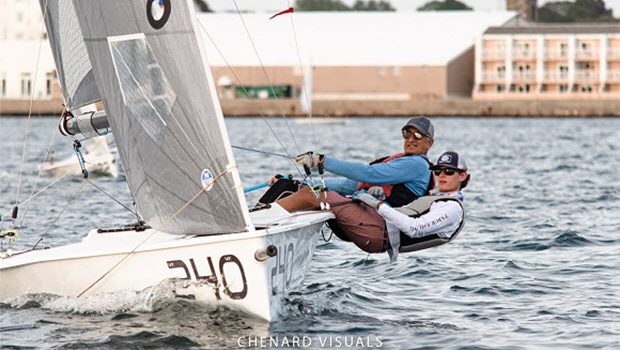What’s old can be new again
Published on November 8th, 2020
In the November 2020 edition of US Sailing’s e-Newsletter for one design sailors, we share a report regarding how intergenerational sailing can make a difference for youth sailors to enjoy lifelong sailing participation.
Sailing with adults and on many different boat types was once the norm for young sailors. But youth sailing, like many other youth sports, has become increasingly specialized in the past few decades.
These days, many young sailors never venture outside of their junior sailing programs to sail with adults, try new boats beyond the mainstream youth sailing classes, or race on an intergenerational team.
However, experiences of Grace O’Neill and Connor Macken, members of US Sailing’s Youth Advisory Board, show that what is old can be new again.
“My experience racing alongside adults has been incredible. Their mentoring has helped me advance as a skipper, crew member, and coach. There is so much information to absorb from older sailors.”
– Grace O’Neill, age 14, Chicago, IL.
“When I was still racing Optis, I asked a coach what else I could do outside of practice to get better. His response was simple. ‘Just Sail. Sail as many different boats as you can.’ Now, seven years later, I can see that this advice was critical to my development as a youth sailor.”
– Connor Macken, age 19, Wellesley, MA.
For Grace, the experience of racing on an intergenerational team exposed her to new life skills and sailing experiences. “My sailing mentors have taught me so much about the importance of collaboration and communication. Our skipper always speaks calmly and is very collected, even when things aren’t going well.
“When the wind went crazy and our spinnaker ripped, he was able to tell me what I needed to do while he kept his cool. Looking back at that experience, it is easy for me to contrast the sailor I was and the sailor I’ve grown into. Now, I am always able to keep my cool and give very specific directions to the benefit of both my students and myself.”
For Connor, an intergenerational connection led to the opportunity to try new boats and learn advanced racing skills. “At a Safety at Sea seminar a few years ago, I was fortunate enough to have Joe Cooper as my instructor. He spoke about his experiences sailing offshore which inspired me to ask if he knew of any opportunities for me to sail on keelboats.
“Joe introduced me to the world of keelboat sailing. I began by joining him on a 40-foot racing boat in the Wednesday night PHRF racing in Newport. One of the biggest adjustments coming from dinghy sailing was learning to alter sail shapes with control lines that are not on 420s or skiffs.
“Learning to use the traveler in concert with the mainsheet helped me deepen my understanding of different leech profiles; having more tools to adjust the mainsail gave me the opportunity to experiment with different amounts of twist that were unachievable in some of the simpler dinghies.”
It may seem simple, but these experiences can have an outsized impact on a young sailor’s future.
“When I was racing, I saw how the skipper gave clear, specific orders so that there was no room for confusion or mishap,” said Grace. “This has helped me implement stronger communication skills in my role as an instructor in training at my yacht club’s junior sailing program.”
“I have spent a good portion of this fall in the J22, Laser, and VX One classes, and each time I come back to the simplicity of the 420, I try to apply different techniques from other classes and see how they translate,” said Connor. “Some work better than others, but I am looking forward to exploring even more classes to continue developing myself as a sailor.”
These experiences are foundational to lifelong sailing participation and to developing the sailing skills to be a future champion.









 We’ll keep your information safe.
We’ll keep your information safe.